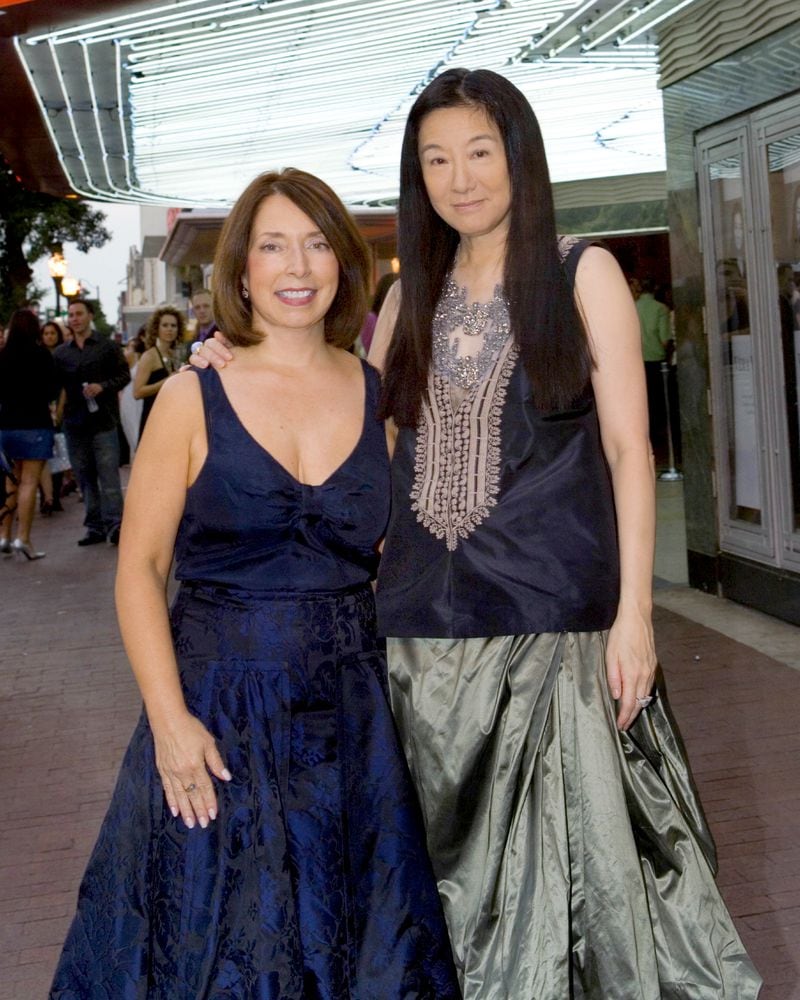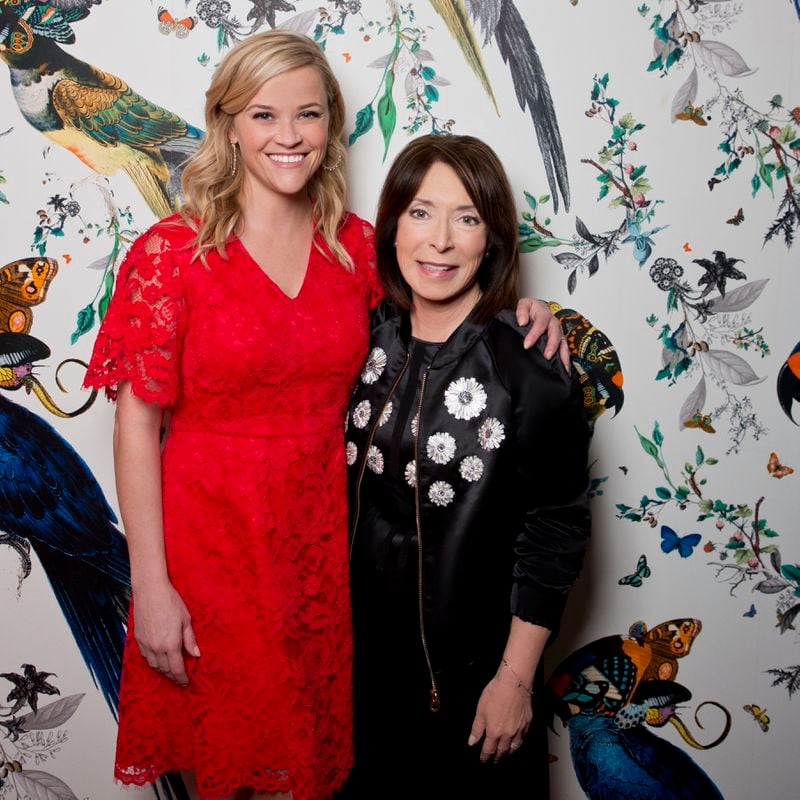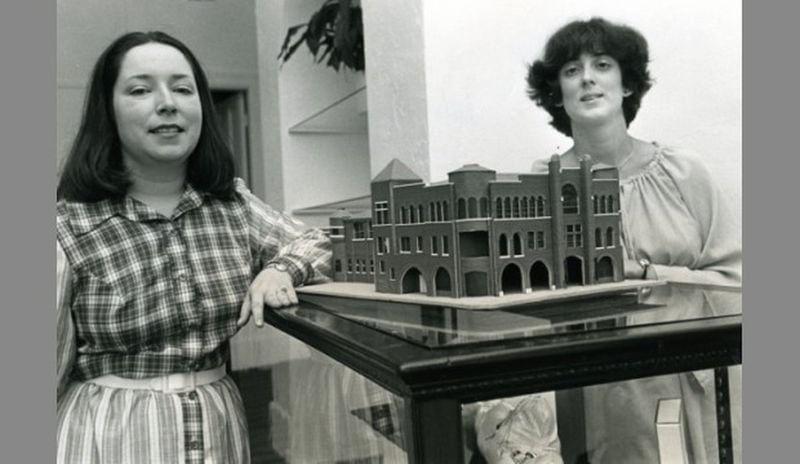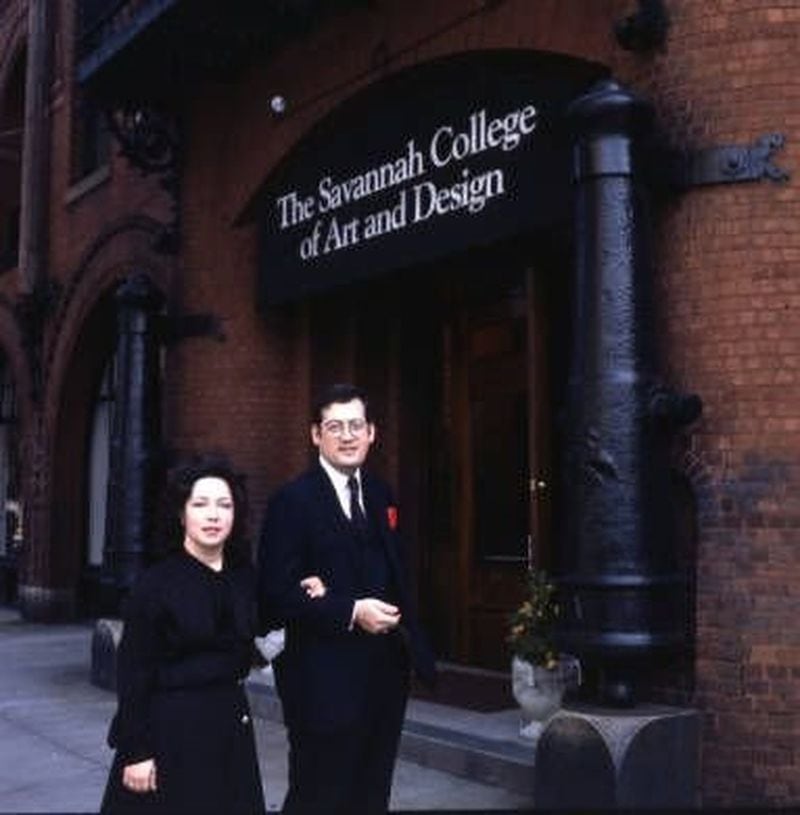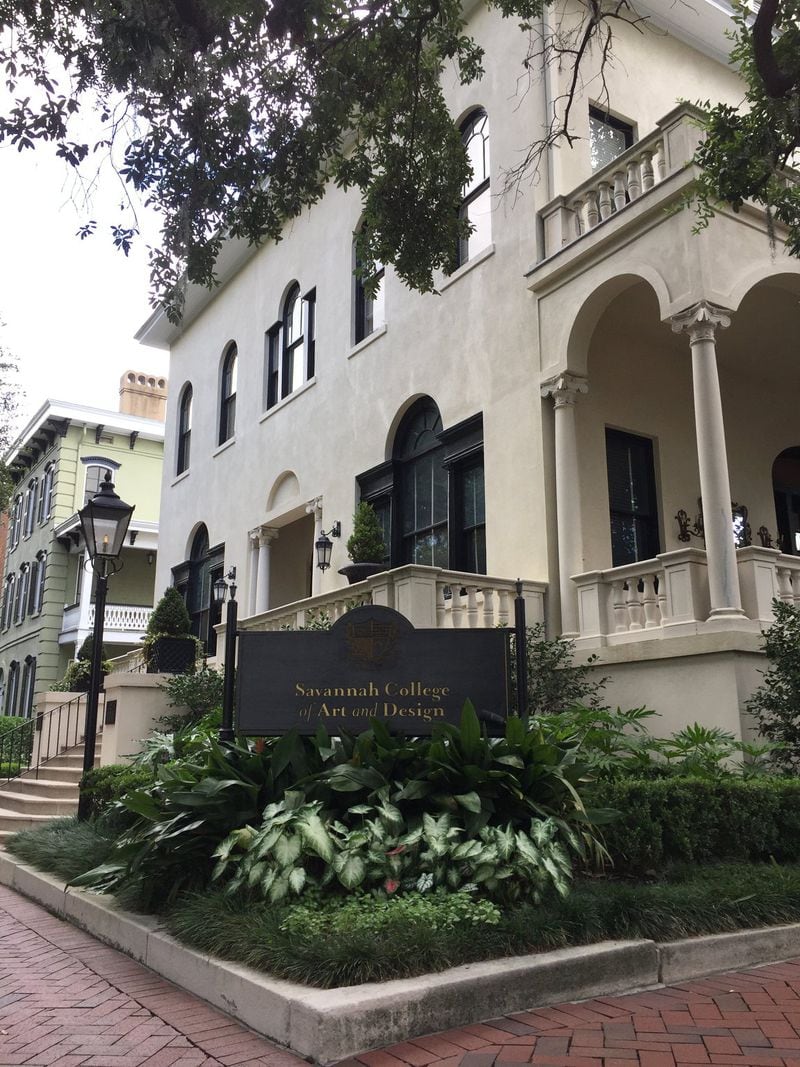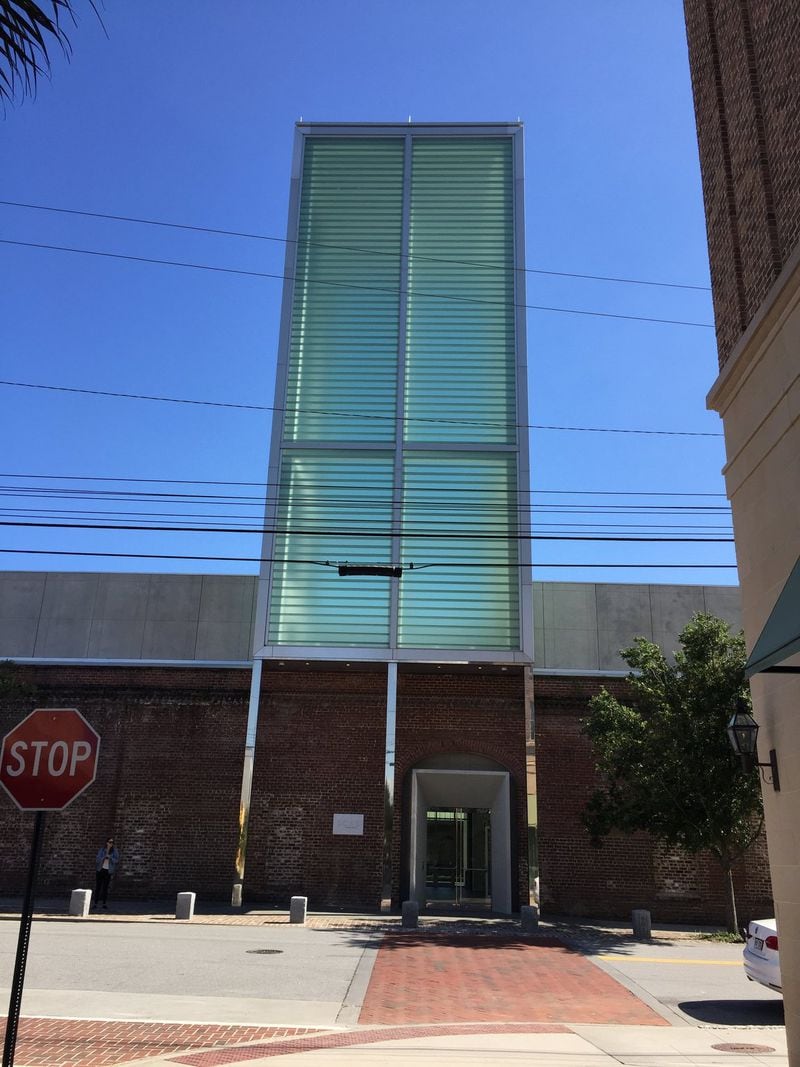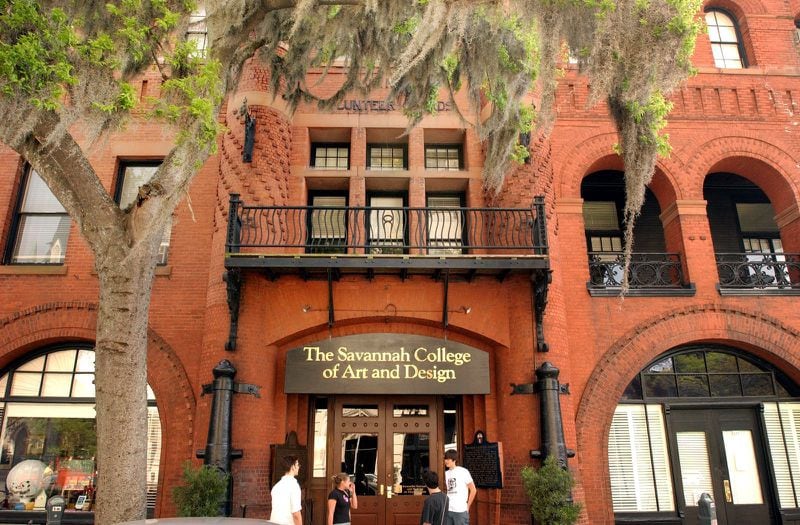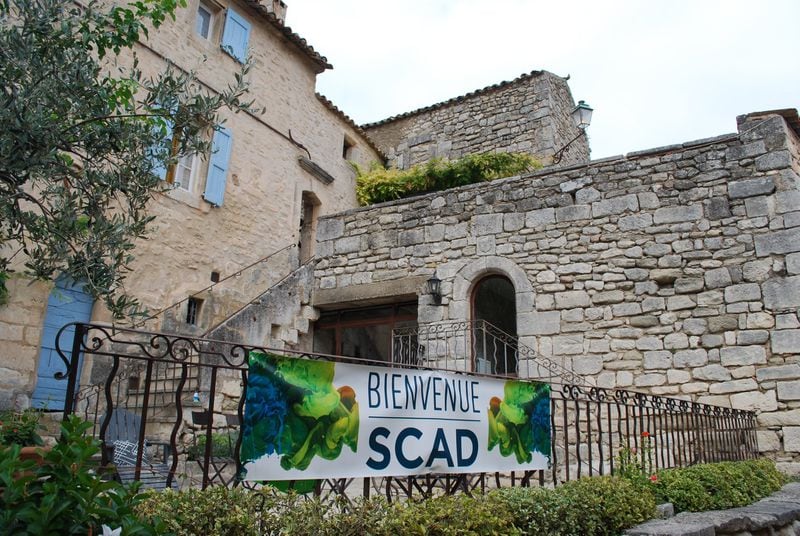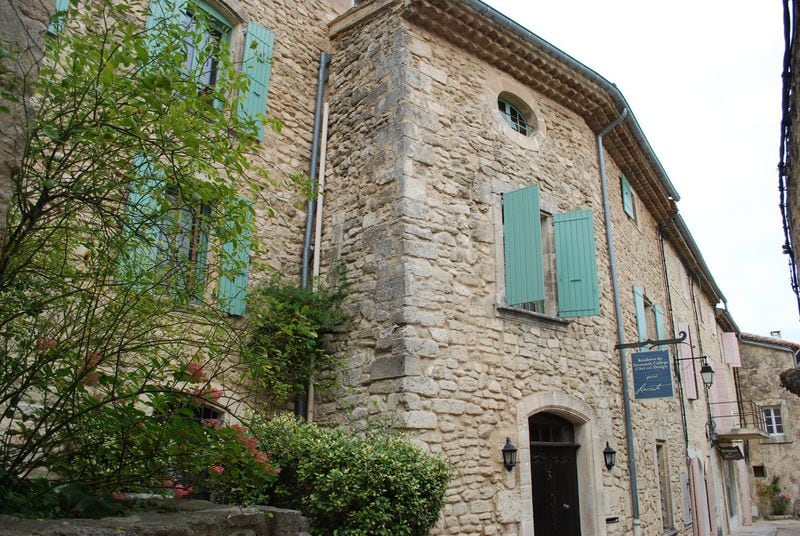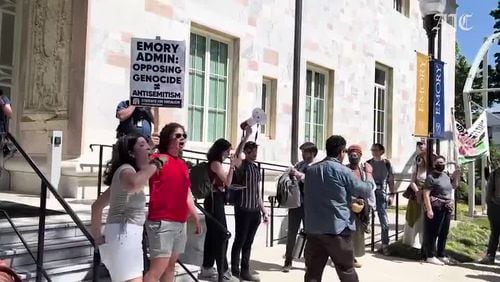The best-paid college president of 2014 walked the red carpet, ready for her close-up.
The limelight is a familiar place for Paula Wallace, president of the Savannah College of Art and Design. On this evening last year, she posed for photographers with her husband at the school’s annual film festival. Often, she appears beside a celebrity visiting SCAD, as the school is known. It might be Liam Neeson, the actor; or Vera Wang, the fashion designer; or Russell Simmons, the hip-hop impresario.
At SCAD, though, Paula Wallace is the star. A full-page magazine ad for the school pictures Wallace on a sound stage. SCAD's website displays not only her biography, but a section headlined "Paula Wallace in the News." SCAD produces videos of Wallace's interviews with actors and artists. Last year, the school published Wallace's memoir, "The Bee and the Acorn," its title a metaphor for SCAD and, perhaps, for Wallace herself.
“The bee, our mascot, defies logic — a fat little creature that isn’t supposed to fly, yet does,” she wrote. “Bees are busy. They build, collaborate, are drawn to beauty and color, and bounce across the summer. And what bees make is sweet, full of light. Next to the bee is the acorn, laughably insignificant at first, one of thousands of hopeful ideas in a world full of them, most of them trampled. But maybe in thirty or forty years, you look up and there it is, an oak, still young, but with strength that will carry it across the centuries.”
Approaching its 40th year, SCAD has matured into one of Georgia's most prominent academic institutions. Its enrollment reached almost 14,000 this fall, rivaling that of Georgia's largest private college, 181-year-old Emory University. SCAD operates campuses in Savannah and Hong Kong, Atlanta and France, each renowned for preserving historic buildings. It offers degrees in of-the-moment fields: luxury and fashion management, motion pictures and television, theme-park design. SCAD succeeds by attracting students who want both artistic achievement and acclaim — and who are undeterred by $50,000 a year in tuition and other fees.
But a cult of personality surrounding Wallace enables her to eclipse her own school and make millions of dollars doing so, an investigation by The Atlanta Journal-Constitution found.
Credit: AJC FILES
Credit: AJC FILES
Wallace, 69, exerts near-total control over the school’s operations and, maybe just as important, its image. From furnishings for campus buildings (which she chooses) to the school song (which she wrote), Wallace puts her imprimatur on all things SCAD. The school silenced dissenters with non-disclosure agreements and threats of lawsuits. It forbade employees from speaking publicly about SCAD without Wallace’s permission in writing. It fired some who reported improprieties or questioned Wallace’s compensation.
To understand the interdependence of Wallace and the school, the Journal-Constitution interviewed current and former faculty members, employees and students and reviewed tax filings, court cases and real-estate records. The examination found that even though SCAD is a nonprofit, tax-exempt organization, it seems to operate more like a private business with an overarching goal: to reward Wallace with wealth and fame.
SCAD gives Wallace a salary and a lifestyle unheard of in higher education. Between 2011 and 2015, the school paid her $19.9 million in salary and other compensation. During the same five years, Harvard University paid its president less than one-third as much. Wallace’s pay spiked to $9.6 million in 2014 — more than any other president of a nonprofit or public university in the United States. She made $2.1 million in 2015.
In its tax returns, SCAD says performance reviews and a consultant's recommendations justify Wallace's compensation. But the benefits don't stop with her paycheck. SCAD provides her with a restored 19th-century house in Savannah, pays her an allowance for a home in Atlanta and maintains a residence that she uses in the Provence region of southern France. Wallace travels on SCAD's private jet or, when she takes commercial flights, in business class. To help Wallace focus on work, SCAD's board decided in 2011 to pay for an assistant to manage her personal affairs.
For Wallace, the personal and the professional are barely distinguishable.
Wallace and 13 members of her family have worked at SCAD during the past 20 years, with combined earnings of $60 million. Wallace made millions more through a real-estate transaction involving SCAD.
Through two spokeswomen, Wallace declined requests for an interview. Over the past two months, the school would neither make other administrators available to speak on Wallace’s behalf nor give on-the-record answers to written questions.
On Wednesday, the chairman of SCAD’s board of trustees, Alan Whitaker, issued a statement expressing the board’s full support for Wallace, saying she “has dedicated her life to the university. Because of her focus on quality, her vision, and her mind for innovation, working alongside our faculty and staff, the university has seen unprecedented fiscal, curricular and campus growth that directly benefits, first and foremost, our talented students. Today, SCAD stands as one of the world’s most preeminent progressive institutions of higher learning, with nearly 40,000 alumni revolutionizing creative industry, from Apple to NASA, Ralph Lauren to BMW.”
In a separate statement, SCAD said its accreditation reports were flawless, its financial audits unblemished. The school also pointed to its commitment to award scholarships and increase its endowment for future growth.
Credit: Chia Chong/Courtesy of SCAD
Credit: Chia Chong/Courtesy of SCAD
In ways that seem unusual for a college president, Wallace embodies the dream that SCAD sells its students. Fashion shows, art installations, film festivals and other gala events in the United States, Europe and Asia put her close to the famous and the glamorous. Her memoir named three dozen celebrities with whom she has mingled: designers, authors, photographers, movie stars. The implication is obvious: Like Wallace, SCAD students can be stars.
Some already are. SCAD graduates thrive in art and graphic design and decorating and many other fields. But at a school that rarely rejects a prospective student, not everyone can excel. For every alumnus working at Pixar, hundreds more students study computer animation each year. One recent graduate acts in a Netflix series, another manages a Chick-fil-A.
"We all had this understanding that if I'm going to this top-notch school, surely I'm going to be top-notch in my industry," said Jenna Schreck, 29, who moved to Los Angeles after graduating in 2012 with a photography degree. "Surely, I would take off a little quicker than anybody else.
“As soon as I got out here, I realized that wasn’t true.”
Schreck rarely takes photographs professionally; she’s too busy scrambling to find work as a freelance assistant producer on commercial photography shoots. She feels captive to the $81,000 in loans that helped pay for her education — and to the payments of almost $800 every month until she’s 56 years old.
"For someone to profit off these kids' dreams, that's really sad." — Photographer and filmmaker David LaChapelle
David LaChapelle, a fine-art photographer and film director from Los Angeles, had never heard of SCAD before last spring, when a friend asked him to speak at a fashion event on the Atlanta campus. In his hotel late the night before the event, he Googled SCAD and found what he called an appalling collection of articles: about Wallace's salary, about the student-loan debt that many graduates carry, about the designers and actors and others who, like him, had been invited to the school for what looked like promotional appearances.
“It’s the antithesis of everything I believe in,” LaChapelle said in an interview this fall. “They were just using me and my name to attract kids there, like I am endorsing that school. That is completely false.”
LaChapelle fulfilled his commitment and accepted an award: the SCAD Etoile, honoring his “global influence on fashion, film and photography.” But he said he avoided Wallace as much as he could. He chafed at her entourage of assistants, who tried to keep him away from students they had not chosen ahead of time. He ended up giving his award to a child in the audience.
“She is an incredibly savvy businesswoman who’s incredibly greedy and self-serving,” LaChapelle said of Wallace. “For someone to profit off these kids’ dreams, that’s really sad.”
The founders
In 1977, Paula Wallace was Paula Rowan. She had taught elementary school in Atlanta since 1971, earning not quite $15,000 a year. And she was restless.
“The world was ready for something new,” she wrote in her memoir. “All around us, dreamers were dreaming up new ideas: ‘Star Wars,’ The Clash, Apple. I was nearing thirty fast and wanted to do something new, too.”
So she moved to Savannah and started an art school.
She would model it, she wrote later, on her classrooms in Atlanta, where she used art and music to teach other lessons to second- and third-graders. “I looked at my young students and wondered: What would they do when they got to college?” she wrote in her memoir. “Where would they go? Would there exist a university like this classroom, where the hands readily made whatever the head dreamed and the heart loved?”
She was not an artist. She had never worked in higher education. Her husband, Richard Rowan, and her parents, Paul and May Poetter, lacked credentials, too. But together they founded SCAD, opening in 1978 in a former armory. Seventy-one students enrolled the first quarter. One graduated in the first commencement.
As a nonprofit, SCAD would avoid state, federal and local taxes, eventually worth millions of dollars a year. It has no owner, no shareholders. Under federal law, it is a public trust. But the founders’ earliest decisions ensured their family would control the school and profit from it for decades to come.
Richard Rowan became the first president, Paula the provost. Her parents took administrative jobs, joined the board of trustees and, in retirement, stayed on as paid consultants. May Poetter continued working for SCAD until she died in 2012, at age 94.
Wallace’s first husband and her current husband; her mother, her father and her father-in-law; her son, her daughter, her son-in-law and her daughter-in-law; her sister, her sister’s former husband, her sister’s daughter and her sister’s daughter’s husband — all have worked for SCAD during the past two decades. But in her memoir, Wallace was dismissive of questions about her family’s dominance of the school.
“Along the way, there (have) been the occasional charges of nepotism, the claim that SCAD only hired and promoted family members, a charge more confusing than anything,” she wrote. “What did anyone expect, that we would try to start something as risky and tenuous as a new college with — what? Strangers?”
Wallace and her family took steps to keep strangers at bay, or at least compliant with their wishes. SCAD offers no tenure or other job protections to professors, all of whom work year-to-year with no guarantees of keeping their jobs. The uncertainty stifles academic freedom, according to the American Association of University Professors, which has kept SCAD on a list of censured institutions since 1993. SCAD has said the sanction is irrelevant, and Wallace described traditional job protections in higher education as "employment constraints."
"It's run on fear and loyalty. Everybody knows you can be fired pretty much for any reason." — A former SCAD professor
Beyond shunning tenure, SCAD requires faculty and staff to sign non-disclosure agreements in which they acknowledge the school may sue them for unapproved public statements, even after they leave. The faculty handbook lists 29 categories of privileged information.
“It’s run on fear and loyalty,” a former SCAD professor said of the school. He spoke on the condition of anonymity because he signed a non-disclosure agreement. “Everybody knows you can be fired pretty much for any reason.”
Paula Wallace’s visceral reactions carry inordinate weight, the former professor said. When she visits classrooms, he said, Wallace might remark, “This is messy,” or “Why is this person not wearing a tie?” Afterward, the former professor said, one of Wallace’s aides returns to chastise the offender.
Wallace sat in on Peter Sakievich's art class on SCAD's Hong Kong campus just before spring commencement in 2016. She didn't say much and left before the class was over, Sakievich said in an interview. A few weeks after Wallace's visit, his supervisor texted him with the news that he was being fired. Sakievich, who now teaches at the Pennsylvania College of Art and Design, said he was told Wallace hadn't cared for his students' work.
“She likes ‘pretty,’” he said.
Overthrow
Savannah being Savannah, wild stories abound from SCAD’s early days. Many of the most lurid tales — “anything but clothes” sex parties and professors running off with students to foreign countries — seem to be as much legend as fact. Others, though, are true.
In the early 1990s, a series of SCAD students and faculty members took their own lives, some in ways that seemed staged as performances. A professor set himself on fire. A student stripped naked and leapt off one of Savannah’s tallest buildings. Around the same time, two small pipe bombs detonated, one in front of a campus building and the other at the site of SCAD’s commencement. No one was injured, but in her memoir, Wallace described the explosives as “murderous.”
Then came what SCAD’s lawyers described in legal documents as a “plot … to effectuate the overthrow of Richard and Paula Rowan.”
SCAD sued dissident students and faculty members, accusing them of conspiring with a competing college, the New York-based School of Visual Arts, to open a Savannah branch. Chatham County Superior Court Judge Charles B. Mikell Jr., who later served on the Georgia Court of Appeals, described the case in his memoirs as the most acrimonious of his career. The suit originally named about a dozen defendants, Mikell wrote, but the Rowans soon presented a list of another 40 or so "enemies."
These new defendants included former members of SCAD's board of trustees, including the novelist Pat Conroy. He had been quoted in The New York Times as saying he quit the board because the trustees had no idea what they were approving and "I was afraid … I'd end up in jail." Claims against Conroy, who died in 2016, were eventually dismissed. But he was quoted as saying he would rather "fight a pit bull with my genitals" than go against the Rowans.
"Something was not right. The school was rotten to the core." — A former SCAD trustee
The case settled without a trial, the details hidden by a confidentiality agreement. Even so, court documents reveal a culture of vindictiveness and distrust, if not paranoia, among SCAD administrators. Evidence showed that SCAD employed private detectives to follow and photograph people who had publicly opposed the school — and even one critic’s daughter, then a student at Georgia Southern University.
“Something was not right,” said a former trustee from that era, asked not to be identified because of SCAD’s history of suing dissenters. “The school was rotten to the core. There was something largely and seriously bad.”
As much as these spectacles captivated Savannah, another drama played out mostly in private.
On April 17, 2000, SCAD announced Richard Rowan would become chancellor, a newly created job, and Paula would be president. “It was a board of trustees decision,” Paula Rowan told the Savannah Morning News. “With a changing world that we’re living in, it’s wise to rethink the roles within an institution.”
Neither the school's announcement nor the news coverage mentioned what had happened three days earlier: A judge in Atlanta had finalized the Rowans' divorce.
The end of the marriage launched a new era at SCAD. Paula Rowan became Paula Wallace on Thanksgiving Day 2000, when she married Glenn Wallace, a SCAD graduate who oversaw the school's physical plant. She was 52. He was 30. Glenn Wallace became senior vice president and, later, chief operating officer. In 2016, SCAD paid him $595,000.
The new job and the new marriage transformed Wallace. Despite her lack of formal training, she described herself as a designer and an author. Over time, her appearance changed, too. She began wearing fashionable clothes and hairstyles as, for the first time, she stood in the spotlight.
“For so long,” she wrote in her memoir, “I was the stage manager of SCAD, behind the curtain, with the clipboard, writing and editing and urging in whispers, and while I am still doing much of the editing, somehow, reluctantly, I have also become the face of this place.”
Richard Rowan left SCAD shortly after the Wallaces married, apparently not of his own volition. The school paid him $4 million for “settlement of all legal claims related to the termination of employment,” including breach of contract and improper termination, according to SCAD’s 2001 tax return. He got another $1.9 million for “future periods” of consulting, the return said. The school also bought a $500,000 house in Hollywood, Florida, where Rowan would live rent-free for five years.
Rowan later bought the house from SCAD but lost it through foreclosure, according to court records in Florida. Numerous efforts to reach him recently were unsuccessful.
Three trustees departed with Rowan, leaving Paula Wallace firmly in charge. Her new husband joined the board of trustees, as did other associates. And when her former husband left SCAD, Wallace got a $750,000 bonus. The payment began a lucrative period for a woman who says she had to sell her car to get the school up and running.
Art of the deal
Deep inside SCAD’s 2002 tax return, a four-line note disclosed an unusual transaction. It said the school had bought a $3.45 million house for Wallace – from Wallace.
The purchase price represented “the average of two independent appraisals for fair market value,” SCAD reported to the Internal Revenue Service. Elsewhere in the tax return, SCAD listed the amount of the purchase as part of Wallace’s compensation for that year.
“The college will use this property to serve as a residence for the president of the institution going forward,” the return said. “The residence is furnished for the convenience of the college, and the president is required to accept such housing as a condition of her employment.”
The tax return did not disclose the property’s address, and no sale involving Wallace and the school was ever recorded in real-estate records.A house near downtown Savannah, which SCAD has owned since 1993, is the school’s presidential residence.
In 2001, when SCAD says the transaction took place, Wallace apparently owned only a house and a vacant lot in The Landings, a sprawling development on Skidaway Island outside Savannah. Wallace and her former husband built the nearly 10,000-square-foot house in the late 1990s, and she got the property in their divorce, according to real-estate records. By then, they had paid off a $1 million construction loan, and in 2001 Wallace owned the property with no outstanding mortgages.
Real-estate records continued to show Wallace as the owner until a series of transactions on a single day in 2006.
On Aug. 9 of that year, SCAD acquired a Savannah house belonging to a company controlled by Nancy Panoz, a founder of the Chateau Elan resort in northeast Georgia. The house had operated as a bed-and-breakfast called the Granite Steps Inn. Public records show the transaction between SCAD and Panoz's company was valued at $3.75 million.
Also on Aug. 9, Wallace gave SCAD an empty lot next to her house in The Landings, valued at $175,000.
Then, still on Aug. 9, Panoz's company acquired the house from Wallace and the adjoining lot from SCAD. Those transactions also were valued at $3.75 million.
The property was worth only half that much, about $1.8 million, according to the Chatham County Board of Assessors. And no other house in The Landings has ever sold for so much, according to the Savannah Board of Realtors, not even larger, more desirable waterfront properties appraised much higher.
It is not clear whether money changed hands during the 2006 transactions. Even so, Wallace apparently had turned a profit of as much as $2.5 million on the house.
Panoz’s company did not fare so well. In 2010, it sold the house and the vacant lot for about $1.4 million, a loss of more than $2.3 million.
Panoz, her lawyer and a spokeswoman for one of her family’s companies did not respond to requests for an interview.
How much Wallace makes from SCAD is a perpetually sensitive subject. The school has paid her at least $1 million a year 10 times since she became president in 2000 and $2 million or more during each of the past five years. The $9.6 million she made in 2014 included about $7.5 million in deferred compensation that rewarded her for agreeing to stay at SCAD until at least 2019, the school’s tax returns said.
Credit: JOEY IVANSCO
Credit: JOEY IVANSCO
In the fall of 2011, SCAD assigned a new employee, attorney Trey Elmer, to analyze Wallace’s pay. Elmer, who came to SCAD from a New York law firm, got the assignment on Nov. 2, his second day on the job. He sent Wallace a draft report on Nov. 20.
Hours later, he was fired.
When Elmer sued, the school responded that he had not been “a good fit for SCAD” and his work didn’t meet its standards. But Elmer’s lawyer, Ashley Madison of Savannah, wrote in court papers: “Elmer’s findings displeased Wallace, who initiated Elmer’s termination immediately upon reading the report.”
Those findings may be forever secret. When SCAD settled Elmer’s suit in 2014, it insisted on keeping the terms confidential. Neither Elmer nor his lawyer can publicly discuss the settlement or the events that led to the lawsuit. The confidentiality agreement, Madison said in an interview, is “iron clad.”
SCAD has used similar agreements to limit public knowledge of how Wallace benefits from the school.
In 2007, Nolan Donnie Arledge, a maintenance supervisor, complained to his boss about being ordered to work on Wallace’s private property, using the school’s materials and supplies. Soon, as a pretense for firing him, SCAD accused Arledge of threatening Glenn Wallace, a lawsuit alleged. Flyers with Arledge’s picture appeared on campus, the lawsuit said, as if he were wanted for a crime.
“Rumors were flying around about how he wants to kill people, that he was trying to threaten other employees — things that are simply not true,” Arledge’s lawyer, Jeremy McKenzie, said in a pre-trial hearing in 2011, according to a transcript. Paula and Glenn Wallace, McKenzie said, “conspired to have this man’s employment terminated because he discovered criminal acts and wouldn’t participate in them any longer.”
SCAD’s lawyers said the school fired Arledge for violating a workplace violence policy. But after four years of litigation, SCAD settled with Arledge. As in other cases, their agreement hinged on confidentiality.
As SCAD dealt with these and other lawsuits, it also spent millions of dollars on special projects that Wallace championed. In just a decade, it opened one satellite campus in Atlanta and another in Hong Kong, an art museum in Savannah and an equestrian center in South Carolina.
It also occupied a village in France.
It takes a village
The first time Wallace visited Lacoste, France, she stood on a terrace atop the medieval village and gazed upon the verdant Luberon Valley.
“I contemplated Cezanne, Monet, Picasso painting the looming Mont Ventoux,” Wallace wrote in her memoir. “They had come here to see something new,” she added. “Would I?”
It was 2002, just before SCAD took possession of the Lacoste School of the Arts. Founded in 1970 by the American artist Bernard Pfriem, the school had attracted a collection of hippies and disaffected scions of wealthy families. A black-and-white photograph from the era captured the school's culture: Students sat in class nude, each sketching a fully clothed model.
"It was a special place," said Victor Sparrow, an artist from Washington who interned at Lacoste under Pfriem and later taught at SCAD in Savannah. "The kind of people who showed up were self-starters. They didn't need a lot of coddling."
Pfriem died in 1996. By the time his school merged with SCAD, it had deteriorated to a handful of rundown old buildings.
Under Wallace's direction, SCAD renovated Pfriem's school — and then took over much of the rest of the village. Fifteen years later, SCAD Lacoste consists of more than 40 buildings, and a typical Provencal village has become an Americanized vision of medieval Europe. On just one street, the town's boulangerie, or bakery, is actually SCAD's library, and facades of old shops give way to art studios, a photography lab, computer stations, and SCAD's welcome center. Rue Saint Trophime could just as easily be Main Street USA. There's even a gift shop.
Near the center of town, a grand three-story house, hand-built with local stone centuries ago, looms over the cobblestone streets. It is the Residence du Savannah College of Art and Design. “Prive,” a sign warns. Private.
This is where Wallace and her family stay when they visit, usually twice a year, said Cedric Maros, the program director of SCAD Lacoste. In the summer of 2016, for instance, Wallace and her husband spent about two weeks in Lacoste with their two youngest children. Glenn Wallace posted pictures on his public Facebook page almost daily: the village’s annual “Grande Parade,” a landscape shot labeled “Morning Sky and Lavender,” a selfie family portrait.
Occasionally, Maros said, others stay in the residence — visiting “dignitaries,” as he put it. Generally, it sits empty unless Wallace is visiting.
SCAD spends about $3 million a year running the Lacoste campus, according to tax documents, even though no more than 90 students take classes there each academic quarter. Still, the school's students and professors vastly outnumber the full-time residents. Only about 20 people remain in Lacoste's original village, with another 400 on the outskirts. English has become the dominant language. One Saturday morning this fall, a young woman uttered a Southern-inflected "Hey" to everyone she met along Rue Basse.
SCAD and other newcomers to Provence — such as the fashion designer Pierre Cardin, who lives part-time in Lacoste in a castle once occupied by the Marquis de Sade — have driven up property values and priced many residents out of the housing market. The regional government began construction this fall on affordable housing for working-class residents. It’s a utilitarian apartment complex just out of view of the historic stone buildings that SCAD lovingly restored.
SCAD employs about 25 housekeepers, landscapers, cafeteria workers and others in Lacoste, Maros said. Residents have little to say about the school. A bartender at one of the two remaining cafes would say only that SCAD’s students and faculty are good for business.
“They’re used to an American presence for more than 40 years,” Maros said one morning in his office, one of the first buildings Pfriem bought. “That’s why we don’t see any resentment from the people. It’s a long history.”
But SCAD fails to honor the history of Pfriem's school, several former staff members and students said. They pointed to Wallace's emphasis on luxury and fame, exemplified by a SCAD promotional video. It called Lacoste a place "where hip and history collide."
“We exposed kids to all of French culture as much as we could,” said one of Pfriem’s former employees, who spoke on the condition of anonymity because he signed a non-disclosure agreement with SCAD. “This is really a different sort of arrangement. This is like Architectural Digest. It’s mind-boggling.”
Illusions
As word spread of Wallace's $9.6 million pay for 2014, SCAD's Hong Kong campus ran short on supplies. "A student said, 'Paula Wallace makes $9 million and I'm sitting here in Hong Kong and I can't print a paper?'" said Susan Cooke, who taught art history there from 2014 until this year.
SCAD’s financial health has always depended almost entirely on tuition and other fees that students pay. As the school expanded to four campuses on three continents, students’ costs rose and rose again.
Many students rely on loans to cover the $50,000 a year in tuition, housing and other fees. SCAD’s 2016 graduates with student loans owed an average of $37,000, about 25 percent more than the national average, according to government data. Student payments from federally guaranteed loans make up more than one-fourth of SCAD’s annual budget.
With SCAD relying so heavily on student revenue, admission is relatively easy. In 2014, the bond-rating firm Moody's said SCAD accepted almost 94 percent of applicants. SCAD claims its acceptance rate runs closer to 70 percent. At the most selective private universities, the rate rarely exceeds 20 to 25 percent. SCAD professors complain that many students arrive ill-equipped and less talented than they think.
“We’re getting anyone and everyone with a pulse and a bank account,” said Sakievich, the former art professor on the Hong Kong campus.
Jordan Barkin of Atlanta earned a master's degree in interior design in 2006 but has never worked as a designer. Barkin, 37, said he realized he had other talents and, after getting his degree, was a magazine editor for a while. Now he contributes articles to the Huffington Post.
“I’m a writer,” he said, “and that’s not a well-paying job.”
SCAD fostered a creative environment, Barkin said, but it doesn’t warn students about the difficulty of making a living and paying off student loans. “They are patrons of the arts and boosters of the arts and they didn’t want to discourage anyone from pursuing the arts.”
The school emphasizes its marketing and public relations, Barkin said. “But it does seem to work for them. Because it burnishes their reputation. It helps their graduates.”
Cooke, who taught art history in Hong Kong, isn’t so sure. By guiding students into programs such as luxury brand management, she said, SCAD creates unrealistic expectations.
“They all think they’re going to work for Prada,” she said. “It’s the lure of celebrity culture. It’s all an illusion.”
The patron
The evening of Oct. 28, brightly lit blue and red streamers extended above Broughton Street in downtown Savannah. A crowd of invited guests, many in formal wear, drank wine and air-kissed in the closed street outside SCAD’s Trustees Theater. A second crowd gathered behind metal barricades: adults and children dressed as zombies and superheroes for Halloween, alongside other locals on high alert for movie-star sightings. A red carpet covered the sidewalk across the street, where the actors Holly Hunter, Robert Pattinson and Patrick Stewart posed for photographers.
It was opening night of the Savannah Film Festival, one of SCAD's signature annual events. All of these — SCADStyle for design and SCAD FASHWKND for couture, among others — reinforce the school's self-image as an incubator for creativity.
Wallace plays dual roles, both host and muse, handing out awards while basking in praise for inspiring artistic achievement.
“I have to say Paula Wallace is a visionary and has done an extraordinary job,” Hunter said as she accepted an “icon” award. “She has heralded a revolution here in Savannah.”
The last screening of the festival’s opening night featured a movie called “Flower,” starring 23-year-old Zoey Deutch. SCAD gave her its “rising star” award, and she reciprocated with a tribute to Wallace.
“She is,” Deutch said, “a true patron of the arts.”
On stage with Deutch, D.W. Moffett, an actor who chairs SCAD’s film and television department, told students in the theater they should feel motivated by the presence of famous actors.
Then, in what could be a mantra at the school Paula Wallace built, he added, "You can become a star."
----------------------------------
How we got the story
Early in 2017, a national study identified the highest-paid U.S. college president of 2014: Paula Wallace of the Savannah College of Art and Design. The Atlanta Journal-Constitution set out to document how Wallace built SCAD into one of the state’s best-known institutions of higher education — and how she has benefited along the way.
The AJC interviewed several dozen current and former faculty members, employees and students, as well as Savannah residents, experts on nonprofit organizations, lawyers and artists. Many, especially those directly connected to SCAD, would not speak on the record because they had signed non-disclosure agreements and feared the school would sue them.
The newspaper examined tax returns that SCAD, a nonprofit, tax-exempt organization, filed during the past 20 years, as well as court cases and real-estate records in Chatham County, and a reporter attended SCAD’s Savannah Film Festival and visited SCAD’s campus in France.
Wallace declined to be interviewed and the school would not answer written questions.
Most details about SCAD come from a variety of public sources.
About the Author

